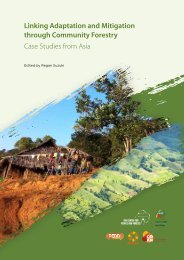Desktop Study on - Regional Climate Change Adaptation ...
Desktop Study on - Regional Climate Change Adaptation ...
Desktop Study on - Regional Climate Change Adaptation ...
You also want an ePaper? Increase the reach of your titles
YUMPU automatically turns print PDFs into web optimized ePapers that Google loves.
Assessment of Capacity Gaps and Needs of South East Asia Countries<br />
in Addressing Impacts, Vulnerability and Adaptati<strong>on</strong> to <strong>Climate</strong> Variability and <strong>Climate</strong> <strong>Change</strong><br />
Figure 2: Nati<strong>on</strong>al level synthesis <strong>on</strong> vulnerability and adaptati<strong>on</strong> – an approach<br />
Stage 4<br />
Sector<br />
Sector<br />
Stage 1<br />
<strong>Climate</strong> <strong>Change</strong><br />
Vulnerability<br />
Food Security<br />
Water Resources<br />
Socio-ec<strong>on</strong>omic<br />
Demographic Pressure<br />
Exploitati<strong>on</strong> of Natural Resources<br />
Emissi<strong>on</strong>s<br />
Country<br />
Specific<br />
<strong>Climate</strong><br />
<strong>Change</strong><br />
Inititatives<br />
Regi<strong>on</strong>al / Nati<strong>on</strong>al /<br />
Sub-nati<strong>on</strong>al climate<br />
strategies<br />
<strong>Climate</strong> Scenarios<br />
Adaptati<strong>on</strong> Pilots<br />
Mainstreaming<br />
Country<br />
Sectors<br />
Projects<br />
Barriers<br />
Socio-ec<strong>on</strong>omic C<strong>on</strong>flicts<br />
Gaps at all levels<br />
Stage 5<br />
Stage 2<br />
Instituti<strong>on</strong>al Capacity<br />
Public Outreach<br />
Stage 3<br />
Disaster Risk Management<br />
Vulnerability Analysis<br />
Source: Authors of this report<br />
ec<strong>on</strong>omic sectors; (ii) identify the less<strong>on</strong>s learnt,<br />
to share am<strong>on</strong>g member countries for capacity<br />
building activities; (iii) highlight gaps in country<br />
level knowledge and capacity in the implementati<strong>on</strong><br />
of vulnerability assessments; and (iv) identify<br />
effective tools and methodologies, capacity building,<br />
and instituti<strong>on</strong>al support modalities for vulnerability<br />
assessments and adaptati<strong>on</strong> activities.<br />
A total of fifteen (15) key studies, each for Lao<br />
PDR, Viet Nam, the Philippines, Ind<strong>on</strong>esia,<br />
Thailand, Cambodia, Myanmar and Malaysia, with<br />
a focus <strong>on</strong> water, agriculture and food security,<br />
and socioec<strong>on</strong>omic adaptati<strong>on</strong> and climate change<br />
related impacts in the last decade were reviewed. .<br />
In order to exemplify the review/ or study process,<br />
a country level approach was followed to synthesize<br />
country level data, informati<strong>on</strong> and knowledge<br />
towards adaptati<strong>on</strong> methods, technologies, best<br />
practices and mainstreaming approach to pave<br />
a way forward in the significant developmental<br />
endeavour of vulnerability and adaptati<strong>on</strong> study. A<br />
three pr<strong>on</strong>ged process covering regi<strong>on</strong>al, country<br />
specific climate adaptati<strong>on</strong> initiatives and local,<br />
sub-nati<strong>on</strong>al and nati<strong>on</strong>al levels were followed. The<br />
overall approach and processes pertaining to all<br />
these steps were embraced with external factors to<br />
keep the perspectives, while analyzing the data and<br />
informati<strong>on</strong> gathered. To c<strong>on</strong>duct the synthesis, a<br />
five-stage process was followed.<br />
Stage 1 in Figure 2 reviews the historical weather<br />
data that are analyzed to understand its significance<br />
in terms of climate change. Historical data are<br />
important as they are used to establish the change at<br />
sectoral levels such as water, agriculture and socioec<strong>on</strong>omic.<br />
Impacts <strong>on</strong> these sectors are of varying<br />
degrees in terms of climate parameters such as,<br />
rainfall amount, number of rainy days, temperature,<br />
intense rainfall leading to floods and changes in<br />
tropical cycl<strong>on</strong>e characteristics and frequencies.<br />
Stage 2 focuses <strong>on</strong> the impacts of future climatic<br />
c<strong>on</strong>diti<strong>on</strong>s under projected climate change scenarios<br />
through their vulnerabilities <strong>on</strong> food security,<br />
water resources and socio-ec<strong>on</strong>omic sectors. Since,<br />
knowledge <strong>on</strong> uncertainty in climate predicti<strong>on</strong>s is<br />
yet to be proven, as seen from available informati<strong>on</strong><br />
and knowledge, some aspects of downscaled climate<br />
data and scenarios are covered. While analyzing<br />
this top down process, where adaptati<strong>on</strong> is imposed<br />
from outside without much c<strong>on</strong>sultati<strong>on</strong> or<br />
interacti<strong>on</strong> (and being science driven), an evaluati<strong>on</strong><br />
of external factors such as, anticipated implicati<strong>on</strong>s<br />
of demographic pressure and exploitati<strong>on</strong> of natural<br />
resources are reviewed to ground the sectoral<br />
approach for a reality check and to find a way<br />
and status of the countries from an aut<strong>on</strong>omous<br />
adaptati<strong>on</strong> to planned adaptati<strong>on</strong> (or adaptive<br />
capacities).<br />
11

















